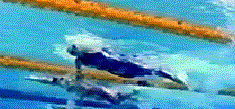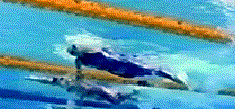HOW CHAMPIONS DO IT
Researched, produced, and prepared by Brent S. Rushall,
Ph.D., R.Psy.

INGE DE BRUIJN AT 25 m OF HER GOLD MEDAL 100 m FREESTYLE RACE AT THE 2000 OLYMPIC GAMES IN SYDNEY
Each frame is .1 seconds apart. Inge De Bruijn's time for this event was 53.83 seconds. This series is offered purely because the standard of visual is slightly better than other analyses from this side.
This stroke analysis includes a moving sequence in real time, a moving sequence where each frame is displayed for .5 of a second, and still frames.
The following image sequence is in real time. It will play through 10 times and then stop. To repeat the sequence, click the browser's "refresh" or "reload" button.

The following image sequence shows each frame for half a second. It will play through 10 times and then stop. To repeat the sequence, click the browser's "refresh" or "reload" button.

At the end of the following narrative, each frame is illustrated in sequence and detail.
Notable Features
- Superb streamline is maintained throughout the whole stroke. Rotation of the hips and shoulders occurs in unison. These two features minimize frontal resistance.
- Stroke rate is high, but slightly less than in the 50-m race analysis.
- Kicks are generally quite shallow. Only in frame #10 does the right thigh drop out of streamline.
- The left arm begins its repositioning immediately upon entering the water. An elbow-up position is quickly established and very powerful adduction of the upper arm drives the left arm propelling surface. The action does not commence with an ideal vertical forearm but by the mid-pull stage it is vertical.
- The trademark characteristic of Inge De Bruijn's stroke, one arm commencing its pull while the other is finishing, is clearly depicted in frame #9. The value of this almost constant application of propulsive force cannot be overemphasized.

Return to Table of Contents for this section.






